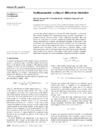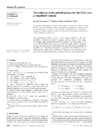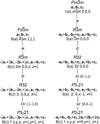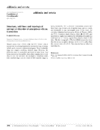issue contents
May 2003 issue

Cover illustration: Polyhedral representation of voids in the sodium-free sublattice of the crystal structure of NaAlSiO4 zeolite. See Blatov & Shevchenko [Acta Cryst. (2003). A59, 34-44].
research papers
A new method of ab initio phase determination is demonstrated which does not rely on reciprocal-space formulations of atomicity.
Classification levels for crystallographic groups are reconsidered and for each level enantiomorphism is discussed. Explicit results are given for dimensions up to 6.
The X-ray scattering by a many-electron atom in a permanent external electric field is developed. It was found that field-induced atomic shell deformations can be neglected during the structure analysis of a crystal in an electric field.
Open  access
access
 access
accessA novel method of scaling diffraction intensities is presented.
A new X-ray dynamical diffraction theory that can deal with n-beam cases comprehensively (n ∈ {3, 4, 6, 8, 12}) has been derived based on the Takagi–Taupin dynamical theory.
A new phasing approach able to solve ab initio protein structures via diffraction data at 1.4 Å resolution is described and tested.
The phase problem of neutron crystallography is formulated as a problem in constrained global minimization, the solution of which, by means of a modified Shake-and-Bake algorithm (Neutron Shake-and-Bake), exploits the property of the neutron density function that it takes negative as well as positive values. The applications show that the positivity of the density function is not only not required for the solution of the phase problem but that positivity is actually a hindrance.
The reconstruction of the charge density of an isolated non-periodic object from X-ray scattering is simulated using direct methods. The ability to phase diffuse scattering is relevant to the imaging of inorganic nanoparticles.
A simple probabilistic formula is derived to estimate protein phases in the single-wavelength diffraction (SAD) case.
A new transition mechanism is proposed for the transformation from the zinc-blende to the NaCl type. It is described by means of a deformation of a heterogeneous sphere packing in space group P32.
Local squaring functions for individual atoms are effective phase refinement and automatic model building tools. The generalization to multiatom fragments is developed.
short communications
Preliminary plots of the abundance of inorganic compounds as a function of their crystallographic parameters disclosed sharp peaks which in some cases corresponded to specific sphere packing or structure types.
The symmetry point-group statistics for all combinatorially different C72 to C100 fullerenes with free 5-gonal facets only are suggested for the first time. The shapes with automorphism group orders not less than 3 are drawn in Schlegel diagrams.
addenda and errata
Free 



 journal menu
journal menu
































